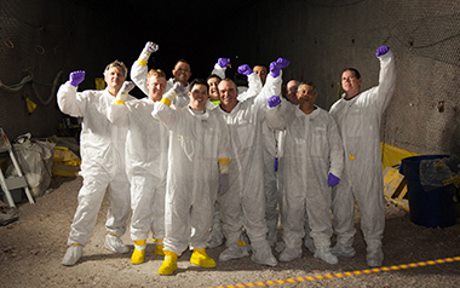Waste emplacement has resumed at the US Department of Energy's (DOE) Waste Isolation Pilot Plant (WIPP), nearly three years after activities were halted following a waste drum rupture in an underground storage panel at the New Mexico facility.
 |
| Workers in WIPP's underground celebrate the completion of the first waste emplacement since 2014 (Image: DOE) |
The first waste emplacement operations were completed on 4 January, with waste from the DOE's Savannah River site which had been in storage at Waste Handling Building (WHB). The official reopening of WIPP was marked on 9 January at a ceremony attended by US Energy Secretary Ernest Moniz and a delegation including New Mexico governor Susana Martinez, senator Martin Heinrich, representatives Steve Pearce and Michelle Lujan Grisham, and mayor of Carlsbad Dale Janway.
Moniz said the "tireless efforts" by the workforce, the contractor and federal management and the community to make WIPP "a safer place" was a "remarkable" feat. "The Department remains committed to safely and responsibly cleaning up the legacy of the Cold War. And, with continuing cooperation with our local partners and the State of New Mexico, WIPP will once again help meet that mission," he said.
WIPP began operations in 1999 and is the USA's only repository for the disposal of transuranic (TRU) wastes from its military program. The wastes - clothing, tools, rags, residues, debris, soil and other items contaminated with small amounts of plutonium and other man-made radioactive elements - are sealed in drums and disposed of underground in rooms mined out of an ancient salt formation.
WIPP operations had been suspended since February 2014 following two unrelated underground incidents. First, operations were stopped following a fire in an underground vehicle on 5 February. Nine days later, a radiological event occurred underground when a waste drum ruptured following an exothermic chemical reaction in organic absorbent material used in the drum to stabilise liquids and nitrate salts.
The DOE commissioned two investigations into the incidents and in October 2014 issued a stepwise recovery plan with the aim of resuming emplacement operations in early 2016. This start date was revised in mid-2015 after further activities identified during the preceding months were added to the project schedule. The plan estimated that the program would cost $242 million up to the restart of operations, not including new permanent ventilation, estimated to cost a further $65 million to $261 million, and a new exhaust shaft, at between $12 million and $48 million.
The DOE authorized operator Nuclear Waste Partnership to resume waste emplacement on 23 December, confirming that all pre-start corrective actions identified in two operational readiness reviews and other required actions had been completed.
All the facilities that generate TRU waste normally sent to WIPP have stored their wastes on-site while the facility has been out of action. All recertified waste from the WHB will be emplaced before WIPP begins accepting new waste shipments. The DOE expects to resume shipments to WIPP in the spring. A schedule for waste shipments has not been finalized, but the DOE expects the facility to ramp up to about five shipments a week later this year.
Researched and written
by World Nuclear News




_18570.jpg)
_16159.jpg)
_49205.jpg)
_18938.jpg)





